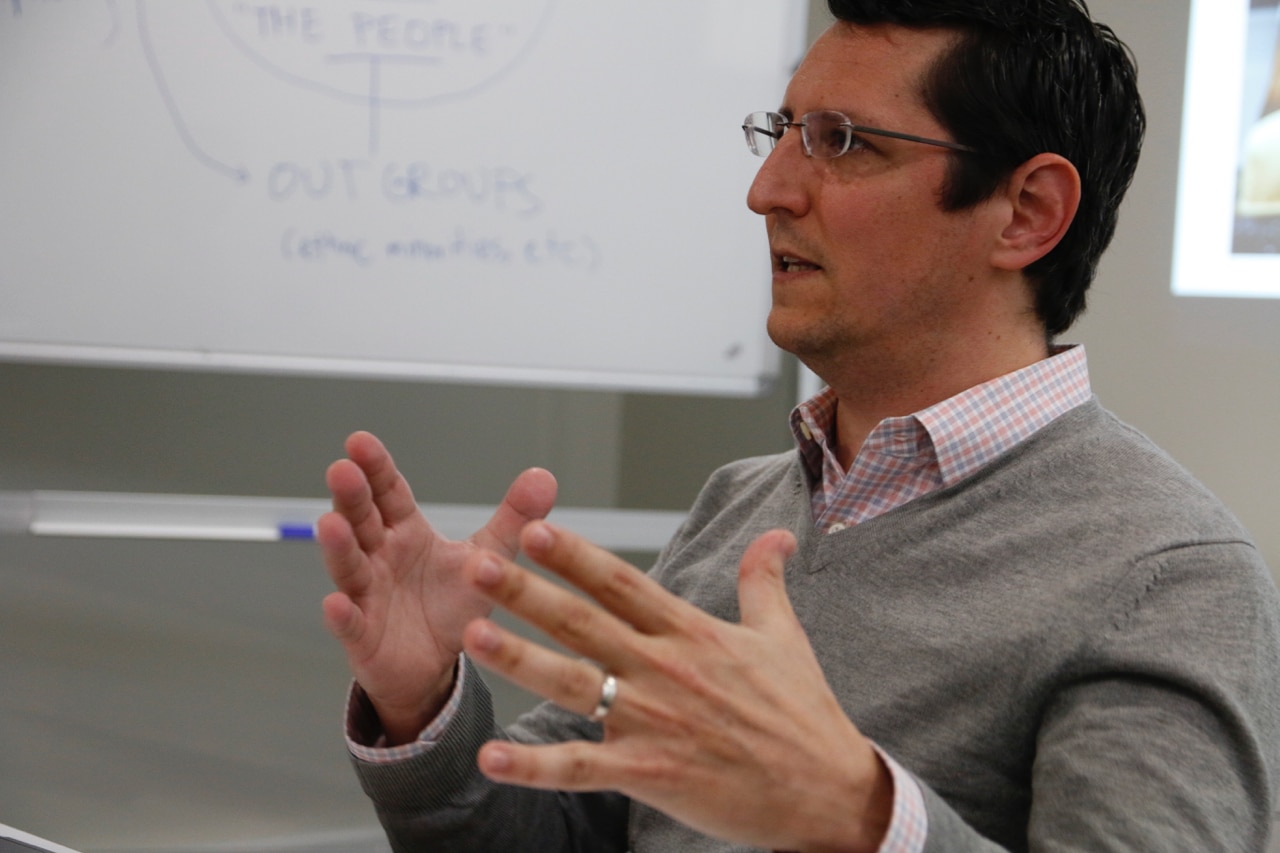“Why are Jews like George Soros being accused of fomenting the migrant crisis in the West? The answers point toward what, in my book-in-progress, I call white populism. I use the term to designate a set of overlapping racialisations that have coalesced into a transatlantic recipe for electoral success,” said STIAS Fellow Dorian Bell of the Department of Literature and Jewish Studies at the University of California Santa Cruz.

“Populist demagogues rail against villainous elites at the top and outgroups at the bottom for colluding against the ‘people’ in between. This much we know from the voluminous recent scholarship on populism. My contribution is to examine how, across the West, the people’s assumed whiteness has emerged reinforced as a result,” he explained. “The results help explain why elites have been represented according to codes once reserved for Jews—and how this relates to the increasingly mainstream notion of a ‘great replacement’ of white Europeans or Americans by Muslim, African and Latino migrants.”
The work forms part of Bell’s book-in-progress, titled Planetary Prejudices: Race, Migration, and Technology in the New Global Order, which he describes as a theoretical attempt to understand how large-scale economic and social shifts are reconfiguring racism. The chapter – from which Bell read an extract – attempts to unpack how the axis of white racial anxiety which is playing out specifically in America and Europe currently is changing what we know about racism. It’s the coming together of what Bell describes as a mixture of “white ethnonationalism, populism, anti-Semitism and Islamophobia.”
“Where the enemies within are seen as aiding the enemies without,’ he added.
He pointed to recent acts of violence against Jewish religious sites including the mass shooting at the Tree of Life Synagogue in Pittsburgh, Pennsylvania, on 27 October 2018 in which 11 people were killed and seven injured making it the deadliest attack on the Jewish community in the United States. The accused perpetrator was Robert Bowers.
“Bowers was an anti-Semitic extremist but his exact motives – as outlined on social media – also dovetail with a larger narrative that is gaining surprisingly mainstream currency.”
A whitelash
“A white populist ‘whitelash’ is battering at Western democracy,” he said. “Terrorism, extremism and xenophobia are the new political normal. What was once fringe, is now mainstream. White populism crosses border- and party-lines, it’s within existing political institutions.”
“There’s a continuity between mainstream political strategies and extremist ravings,” he said.
He pointed to examples in the political speeches and social media outputs of Marine Le Pen in France and Matteo Salvini in Italy as well as Donald Trump.
“It’s presented as a tale of demographic doom. It depicts whiteness as a culture in need of protection. It’s whiteness in search of culprits. And the notion of race war is at the heart of the right-wing revolution.”
“We are seeing definitions of whiteness in journalism, social media, in particular, and politics that would not have been out of place 50 years ago. It’s in part about reproducing old anti-Semitic theories but updated for the contemporary moment – a post anti-Semitism.”
“Nineteenth century nations often defined themselves by excluding Jews,” he said. “Post anti-Semitism deploys but updates these tropes. It’s a re-energising of anti-Semitism but also the representation of racial collusion in an almost zombified way.”
He described the theory of triadic populism – which sees ‘the people’ as being battered both from elites above and outgroups (migrants, etc.) from below. With the elite seen as colluding with outgroups.
“White populism is triadic populism ran amok,” he said, “depicting conspiratorial, twinned enemies against the real people.”
“The long-standing far-right fascination with Jews and immigrants and the ongoing clash between sedentary versus nomadic people echoes a larger racial narrative – of global elites, a Jewish global conspiracy, and unchecked migration as the white minority suffers.”
“I believe white populism intertwines anti-Semitism and Islamophobia to dangerous ends,” he said.
The enemies from above – as Soros has been depicted – are seen as occupying positions as a cultural elite in business, academia, Hollywood and the European Union. He pointed out that Soros’ photo was used in his homeland of Hungary on a political billboard that strongly echoed Nazi-era propaganda. When the government was taken to task on this they pledged funding to fight such anti-Semitism – but implied it was a Muslim problem. Because those who aspire to political power can’t deploy the narrative of overt anti-Semitism instead they denounce Islam, and promote anti- migrant conspiracies even though in Europe the arrival of migrants slowed down considerably after 2015. Soros has also been depicted regularly as conspiring against other European countries.
Bell pointed out that in countries like France and Germany even as little as a year ago this would not have gained traction – “they are the countries with the deepest taboos about anti-Semitism”.
“Trump, on the other hand, paints an epic conflict between the white Christian world and the migrants from the South but also points to ‘Jewish power’ in global power structures.”
“People voted for Trump despite his obvious racism,” he added.
Asked why he doesn’t only use the term white supremacy or extremism, Bell explained “it confines a problem in popular discussion to the extremist fringe”.
“Populism as a term is not pejorative,” he continued. “There’s nothing wrong with how people define, enforce, augment and cement themselves – the problem is the unpleasant side. The vocabulary of populism allows me to describe how white supremacy is reinforcing and expanding itself.”
In discussion he addressed how issues of competition and meritocracy alongside physical outnumbering have historically always been part of these arguments. He also pointed to the importance of the role of the economic dimension particularly in the wake of the economic collapse in 2008.
“There is a long history of supposed collusion between elites and outgroups,” he added. “However, the story hasn’t been told well enough – I’m hoping my work will add to this.”
Michelle Galloway: Part-time media officer at STIAS
Photograph: Christoff Pauw
